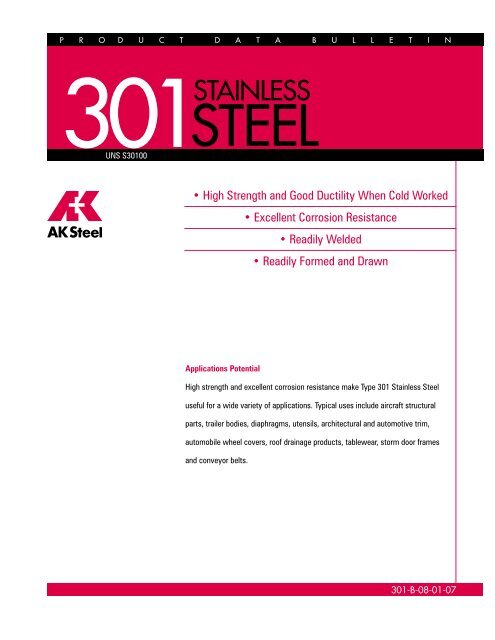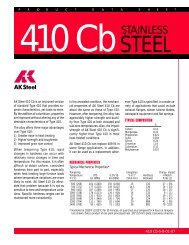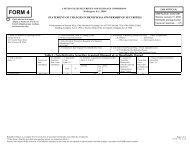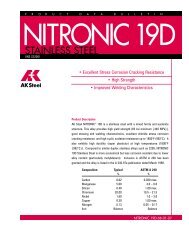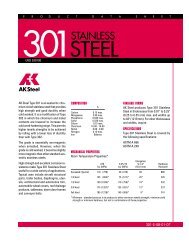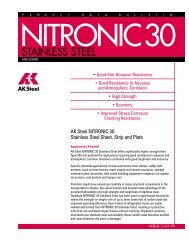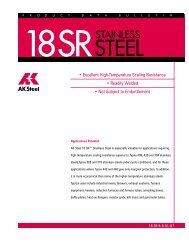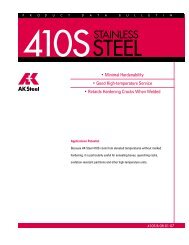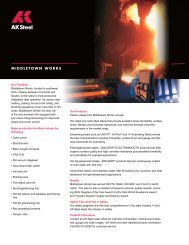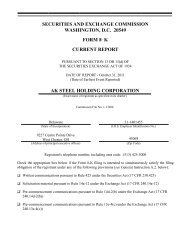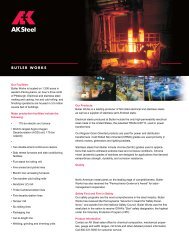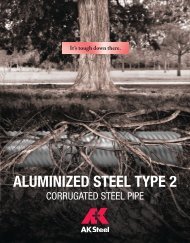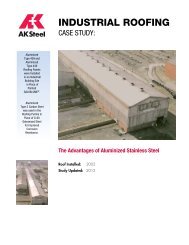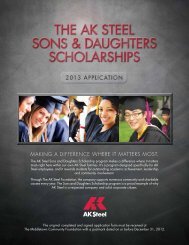STAINLESS - AK Steel
STAINLESS - AK Steel
STAINLESS - AK Steel
Create successful ePaper yourself
Turn your PDF publications into a flip-book with our unique Google optimized e-Paper software.
P R O D U C T D A T A B U L L E T I N<br />
301<br />
<strong>STAINLESS</strong><br />
STEEL<br />
UNS S30100<br />
• High Strength and Good Ductility When Cold Worked<br />
• Excellent Corrosion Resistance<br />
• Readily Welded<br />
• Readily Formed and Drawn<br />
Economical Oxidation Resistance<br />
Applications Potential<br />
High strength and excellent corrosion resistance make Type 301 Stainless <strong>Steel</strong><br />
useful for a wide variety of applications. Typical uses include aircraft structural<br />
parts, trailer bodies, diaphragms, utensils, architectural and automotive trim,<br />
automobile wheel covers, roof drainage products, tablewear, storm door frames<br />
and conveyor belts.<br />
301-B-08-01-07<br />
1
2<br />
<strong>AK</strong> STEEL 301 <strong>STAINLESS</strong> STEEL<br />
Table of Contents<br />
Page<br />
Applications Potential ............................................... 1<br />
Product Description .................................................. 3<br />
Composition ............................................................. 3<br />
Available Forms ........................................................ 3<br />
Metric Practice ......................................................... 3<br />
Mechanical Properties ........................................... 4-5<br />
Physical Properties ................................................... 6<br />
Corrosion Resistance ................................................ 6<br />
Oxidation Resistance ................................................ 6<br />
Heat Treatments ....................................................... 6<br />
Cold Working ............................................................ 6<br />
Formability................................................................ 6<br />
Weldability................................................................ 7<br />
Specifications ........................................................... 7<br />
The information and data in this product data bulletin are accurate to<br />
the best of our knowledge and belief, but are intended for general<br />
information only. Applications suggested for the materials are<br />
described only to help readers make their own evaluations and<br />
decisions, and are neither guarantees nor to be construed as express<br />
or implied warranties of suitability for these or other applications.<br />
Data referring to mechanical properties and chemical analyses are<br />
the result of tests performed on specimens obtained from specific<br />
locations of the products in accordance with prescribed sampling<br />
procedures; any warranty thereof is limited to the values obtained at<br />
such locations and by such procedures. There is no warranty with<br />
respect to values of the materials at other locations.<br />
<strong>AK</strong> <strong>Steel</strong> and the <strong>AK</strong> <strong>Steel</strong> logo are registered trademarks of <strong>AK</strong> <strong>Steel</strong><br />
Corporation.
PRODUCT DESCRIPTION<br />
Type 301 is an austenitic chromium-nickel stainless steel<br />
that provides high strength and good ductility when cold<br />
worked. It is a modification of Type 302 in which the<br />
chromium and nickel contents are lowered to increase<br />
the cold work-hardening range. This permits higher tensile<br />
strengths to be achieved by rolling with a lower loss<br />
of ductility than with Type 302.<br />
The grade is essentially non-magnetic when annealed.<br />
However, when the grade is cold worked, it becomes<br />
more magnetic than other standard austenitic stainless<br />
steels.<br />
Composition<br />
Carbon 0.15 max.<br />
Manganese 2.00 max.<br />
Phosphorus 0.045 max.<br />
Sulfur 0.030 max.<br />
Silicon 0.75 max.<br />
Chromium 16.00 - 18.00<br />
Nickel 6.00 - 8.00<br />
Nitrogen 0.10 max.<br />
Iron Balance<br />
%<br />
Available Forms<br />
<strong>AK</strong> <strong>Steel</strong> produces Type 301 Stainless <strong>Steel</strong> in thicknesses<br />
from 0.01" to 0.25" (0.25 to 6.35 mm) max. and<br />
widths up to 48" (1219 mm). For other thicknesses and<br />
widths, inquire.<br />
Metric Practice<br />
Values shown in this bulletin were established in U.S.<br />
customary units. The metric equivalents of U.S. customary<br />
units shown may be approximate. Conversion to the<br />
metric system, known as the International System of<br />
Units (SI), has been accomplished in accordance with<br />
ASTM E380.<br />
The newton (N) has been adopted by the SI as the metric<br />
standard unit of force as discussed in the AISI Metric<br />
Practice Guide. The term for force per unit of area<br />
(stress) is the newton per square metre (N/m 2 ). Since<br />
this can be a large number, the prefix mega is used to<br />
indicate 1,000,000 units and the term meganewton per<br />
square metre (MN/m 2 ) is used. The unit (N/m 2 ) has been<br />
designated a pascal (Pa). The relationship between the<br />
U.S. and the SI units for stress is: 1000 pounds/in 2 =<br />
1 kip/in 2 = 6.8948 meganewtons/m 2 (MN/m 2 ) = 6.8948<br />
megapascals (MPa).<br />
3
4<br />
Mechanical Properties<br />
Table 1<br />
Room Temperature Properties*<br />
UTS 0.2% YS<br />
Elongation<br />
% in 2" Hardness<br />
ksi (MPa) ksi (MPa) (50.8 mm) Rockwell<br />
Annealed (typical) 110 (758)* 40 (276)* 60* B85<br />
1/4 Hard 125 (862)* 75 (517)* 25* C25<br />
1/2 Hard 150 (1034)* 110 (758)* 18* C32<br />
3/4 Hard 175 (1207)* 135 (931)* 12* C37<br />
Full Hard 185 (1276)* 140 (965)* 9* C41<br />
* Minimum - standard practice is to produce to either minimum tensile strength, minimum<br />
yield streng th or minimum hardness, but not to combinations of these properties.<br />
Table 2<br />
Elevated Temperature Properties*<br />
Temperature UTS 0.2% YS<br />
Elongation<br />
% in 2"<br />
°F (°C) ksi (MPa) ksi (MPa) (50.8 mm)<br />
Room 185 (1276) 151 (1041) 9.0<br />
200 (93) 174 (1200) 145 (1000) 7.0<br />
400 (204) 168 (1158) 140 (965) 4.5<br />
600 (316) 156 (1076) 130 (896) 6.0<br />
800 (427) 145 (1000) 119 (820) 6.0<br />
*Full-Hard Sheet<br />
Table 3<br />
Sub-Zero Properties<br />
Test Elongation<br />
Temperature UTS 0.2% YS % in 2"<br />
°F (°C) ksi (MPa) ksi (MPa) (50.8 mm)<br />
Annealed Condition<br />
-320 (-196) 275 (1896) 75 (517) 30<br />
-80 (-62) 195 (1344) 50 (345) 40<br />
-40 (-40) 180 (1241) 48 (331) 42<br />
32 (0) 155 (1069) 43 (296) 53<br />
70 (21) 110 (758) 40 (276) 60<br />
Half-Hard Condition<br />
-320 (-196) 290 (1999) 115 (793) 25<br />
-80 (-62) 205 (1413) 105 (724) 37<br />
-40 (-40) 188 (1296) 101 (696) 38<br />
32 (0) 170 (1172) 98 (676) 46<br />
70 (21) 150 (1034) 110 (758) 48
Table 4<br />
Impact Strength<br />
Test Temperature Izod V-Notch, ft-lbs (J)<br />
°F (°C) Annealed 1/4-Hard<br />
-320 (-196) 114 (161) 100 (136)<br />
-80 (-62) 112 (126) 100 (136)<br />
-40 (-40) 110 (123) 100 (136)<br />
32 (0) 108 (121) 100 (136)<br />
70 (21) 102 (114) 100 (136)<br />
Stress, 1000 PSI<br />
Percent in 2 in.<br />
280<br />
260<br />
240<br />
220<br />
200<br />
180<br />
160<br />
140<br />
120<br />
100<br />
80<br />
60<br />
40<br />
20<br />
0<br />
Ultimate<br />
Composition:<br />
C .11 Cr 16.97 Ni 7.26<br />
Mn 1.18 Si .42<br />
80<br />
70<br />
60<br />
50<br />
40<br />
30<br />
20<br />
10<br />
0<br />
0 10 20 30 40 50 60<br />
% Cold Reduction<br />
Effect of Cold Work on Tensile Properties<br />
Elongation<br />
Yield<br />
Hardness<br />
80<br />
70<br />
Hardness, Rockwell A<br />
60<br />
50<br />
40<br />
5
6<br />
Physical Properties<br />
Density, 0.285 lbs/in 3<br />
7.88 g/cm 3<br />
Electrical Resistivity, microhm-in (microhm-cm)<br />
68°F (20°C) – 27.4 (69.5)<br />
Specific Heat, BTU/lb/ o F (kJ/kg•K)<br />
32-212°F (0-100°C) – 0.12 (0.50)<br />
Thermal Conductivity, BTU/hr/ft 2 /ft/ o F (W/m•K)<br />
at 212°F (100°C) – 9.4 (16.2)<br />
at 932°F (500°C) – 12.4 (21.4)<br />
Mean Coefficient of Thermal Expansion,<br />
in/in/ o F (µm/m•K)<br />
32 – 212°F (0 - 100°C) – 9.4 x 10 -6 (16.9)<br />
32 – 600°F (0 - 315°C) – 9.9 x 10 -6 (17.8)<br />
32 –1000°F (0 - 538°C) –10.2 x 10 -6 (18.4)<br />
32 –1200°F (0 - 649°C) –10.4 x 10 -6 (18.7)<br />
Modulus of Elasticity, ksi (MPa)<br />
28.0 x 10 3 (193 x 10 3 ) in tension<br />
11.2 x 10 3 (178 x 10 3 ) in torsion<br />
Magnetic Permeability, H = 200 Oersteds<br />
Annealed – 1.02 max.<br />
Melting Range, °F (°C) – 2250 - 2590 (1399 - 1421)<br />
Corrosion Resistance<br />
Type 301 Stainless <strong>Steel</strong> exhibits corrosion resistance<br />
comparable to Types 302 and 304 in the milder service<br />
conditions. Resistance to atmospheric corrosion, food,<br />
juices and road de-icing salt is excellent. The best corrosion<br />
resistance is obtained in the cold worked then<br />
annealed condition. When Type 301 is heated or cooled<br />
through a temperature range of 800 - 1600°F (427 -<br />
871°C) without subsequent annealing, it may undergo<br />
carbide precipitation that may result in intergranular<br />
corrosion.<br />
Oxidation Resistance<br />
The maximum temperature to which Type 301 can be<br />
exposed continuously without appreciable scaling is<br />
about 1600°F (871°C). For intermittent exposure, the<br />
maximum exposure temperature is about 1450°F<br />
(788°C).<br />
Heat Treatments<br />
Type 301 is non-hardenable by heat treatment.<br />
Annealing: Heat to 1900 - 2050°F (1038 - 1121°C), then<br />
water quench.<br />
Stress Relief Annealing: Heat to 500 - 900°F (260 -<br />
482°C), then air cool.<br />
Cold Working<br />
High hardness and strength for structural applications<br />
are achieved through cold working. In addition to the<br />
annealed condition (110 ksi {758 MPa} tensile strength),<br />
Type 301 strip normally is produced in various cold-rolled<br />
tempers up to full hard (185 ksi {1276 MPa} minimum<br />
tensile strength).<br />
Heavily cold-rolled material has a lowered modulus of<br />
elasticity and exhibits directional properties in that the<br />
compressive yield strength in the longitudinal direction<br />
is lower than the longitudinal tensile yield strength. These<br />
directional properties can be minimized and the modulus<br />
raised by stress relieving for up to eight hours at<br />
about 800°F (427°C). Stress relieving is also recommended<br />
to improve the performance of heavily coldworked<br />
parts such as springs.<br />
Although Type 301 work hardens rapidly, it is one of the<br />
most readily formed stainless steels. It is possible to<br />
stretch form this grade more severely than other 300<br />
series grades. This is due to the high work-hardening<br />
rate which increases the strength to compensate for<br />
the reduction in cross-sectional area. One of the few<br />
forming operations in which high work hardening may<br />
be detrimental is deep drawing. Type 301 is not normally<br />
recommended for the most severe deep drawing<br />
operations where successive draws will be used.<br />
Formability<br />
Type 301 can be readily formed and drawn. Due to its<br />
high work-hardening rate, intermediate annealing may<br />
be necessary for severe drawing and forming operations.
Weldability<br />
The austenitic class of stainless steels is generally considered<br />
to be weldable by the common fusion and resistance<br />
techniques. Special consideration is required<br />
to avoid weld “hot cracking” by assuring formation of<br />
ferrite in the weld deposit. This particular alloy is generally<br />
considered to have similar weldability than the<br />
most common alloy of this stainless class, Type 304L<br />
Stainless <strong>Steel</strong>. A major difference is the high C content<br />
for this alloy, which causes the weld heat-affectedzones<br />
to be susceptible to accelerated corrosion (I.G.C.)<br />
in certain environments. When a weld filler is needed,<br />
AWS E/ER 308 is most often specified. Type 301 Stainless<br />
<strong>Steel</strong> is well known in reference literature and more<br />
information can be obtained in the following ways:<br />
1. ANSI/AWS A5.9, A5.22 and A5.4 (filler metals,<br />
minimum UTS and elongation).<br />
2. “Welding of Stainless <strong>Steel</strong>s and Other Joining<br />
Methods,” SSINA, (800:982-0355).<br />
3. “Welding Stainless <strong>Steel</strong>s,” FDB #SF-1.<br />
4. ANSI/AWS B2.1.009-90<br />
(GTAW 300’s @ 0.50" - 0.14").<br />
5. ANSI/AWS B2.1-8-024-94<br />
(GTAW 300’s @ 1/8" - 1-1/2").<br />
6. ANSI/AWS B2.1.013-91<br />
(SMAW 300’s @ 0.050" - 0.14").<br />
7. ANSI/AWS B2.1-8-023-94<br />
(SMAW 300’s @ 1/8" - 1-1/2").<br />
8. ANSI/AWS B2.1.005-90<br />
(GMAW 300’s @ 0.050" - 0.14").<br />
Specifications<br />
Type 301 Stainless <strong>Steel</strong> is covered by the following<br />
specifications:<br />
ASTM A 240<br />
ASTM A 666<br />
7
8<br />
<strong>AK</strong> STEEL 301 <strong>STAINLESS</strong> STEEL<br />
Customer Service 800-331-5050<br />
<strong>AK</strong> <strong>Steel</strong> Corporation<br />
9227 Centre Pointe Drive<br />
West Chester, OH 45069<br />
www.aksteel.com<br />
© 2007 <strong>AK</strong> <strong>Steel</strong> Corporation<br />
PD-134 7180-0087 PDF 7/07


